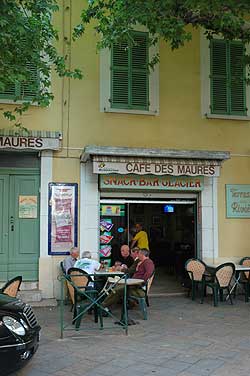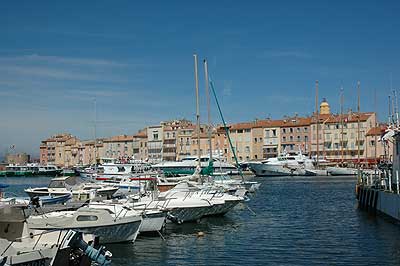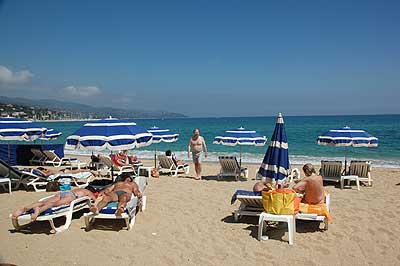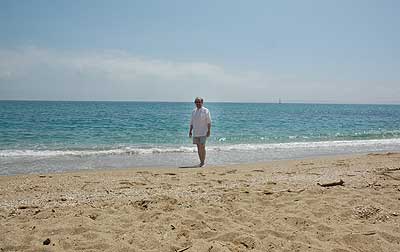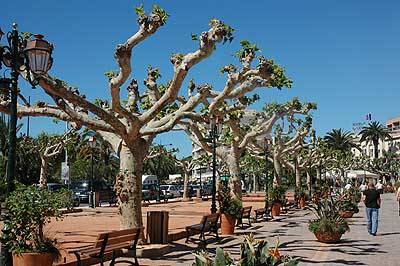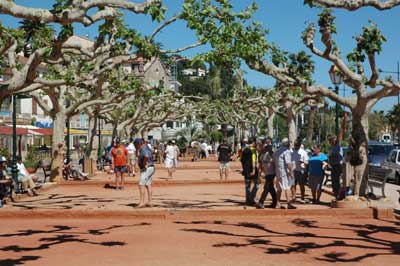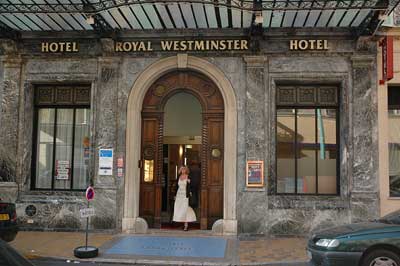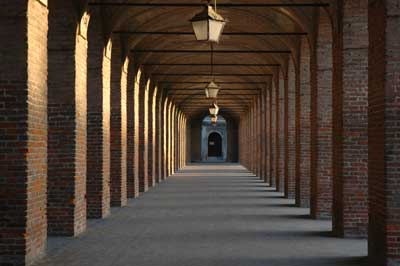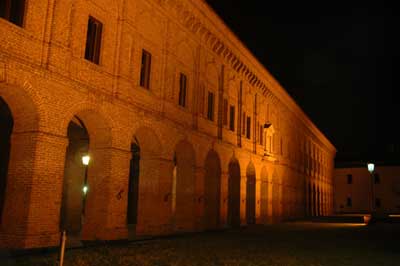ITALY / SWITZERLAND / FRANCE TRIP - 2007
Part Two
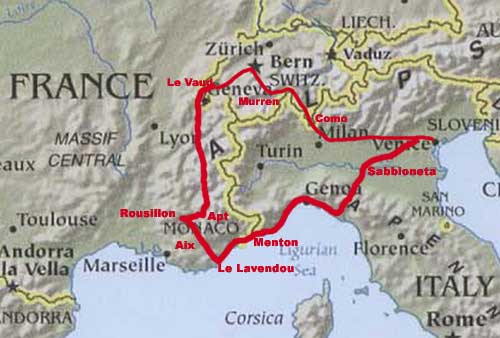
Provence
 The next morning, Friday, we awoke to hazy skies that suggested rain might be on its way. We headed towards the border near Geneva and crossed into France. Crossing borders is no longer exciting as they generally wave you through with no stamping of the passport as in earlier time. We took the autoroute to Grenoble, then the Route de Napoleon to Sisteron. We stopped for lunch in Forcalclier then on to Apt in Provence where it was raining on and off. We found a hotel (L'Aptois Hotel) across the street from the market square (56 Euro) and scouted out the town's restaurants for supper. We settled on one (Restaurant L'Intramuros) that offered local fare: foiegras pate, rabbit with a dish of onions/chestnut, baked potato stuffed with tapenade, and a cacao fondant for dessert (G) and a spinach and tomato lasagne (T). We enjoyed a very nice Luberon wine with the meal.
The next morning, Friday, we awoke to hazy skies that suggested rain might be on its way. We headed towards the border near Geneva and crossed into France. Crossing borders is no longer exciting as they generally wave you through with no stamping of the passport as in earlier time. We took the autoroute to Grenoble, then the Route de Napoleon to Sisteron. We stopped for lunch in Forcalclier then on to Apt in Provence where it was raining on and off. We found a hotel (L'Aptois Hotel) across the street from the market square (56 Euro) and scouted out the town's restaurants for supper. We settled on one (Restaurant L'Intramuros) that offered local fare: foiegras pate, rabbit with a dish of onions/chestnut, baked potato stuffed with tapenade, and a cacao fondant for dessert (G) and a spinach and tomato lasagne (T). We enjoyed a very nice Luberon wine with the meal.
Next morning the rain had stopped and the skies were trying to clear. It was market fair day in Apt so we perused the stalls buying local herbs and foie gras before taking off to another smaller Provence village - Roussillon.
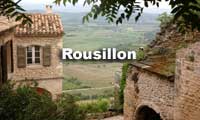
Roussillon is a village perched on the hills high up in the rocky chaine of the Luberon in the heart of Provence. Lovely from the exterior, set in a deep green pine forest on bright red-ochre hills, Roussillon is just as spectacular inside the village with the delightful old buildings and narrow medieval streets. Small in actual size, it is easy to feel familiar and at home there. Situated in the heart of one of the biggest ochre deposits in the world, Roussillon is famous for its magnificent red cliffs and ochre quarries. The red, yellow and brown shades of the earth form a striking contrast with the lush green pine trees.
 |
We decide to use Rousillon as our base and found a modest and pleasant B&B in town (with parking). Lunch was wonderful. We found a small local restaurant, Brasserie La Sirmonde, where George enjoyed a lamb chop and fries while Tana discovered what a real French omelette is like.
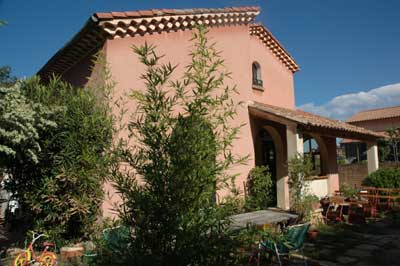
Then we set off to see Roussillon's rich sister Gordes. Standing on the edge of the plateau of Vaucluse, Gorges is one of the "in" villages of Luberon where many movies stars, artists and the rich have made their home. Its houses of white and gray stone rise up in a spiral around the rock perch on which the village is set. At the very top is the church and the castle which face out onto the hills of the Luberon. La Mistral (the strong westerly wind) was blowing us around so we left after a short time
From Gordes we travelled a very windy and narrow road to t he Cistercian Abbaye Notre-Dame de of Senanque and its lavender fields. Senanque is a proper working monastery where the monks make honey, lavender oils and liqueurs.
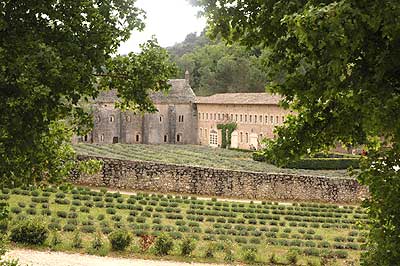
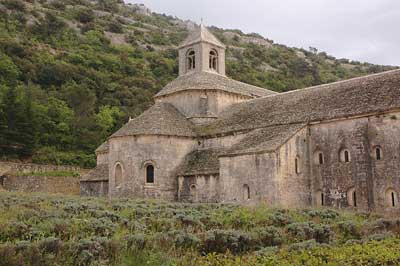
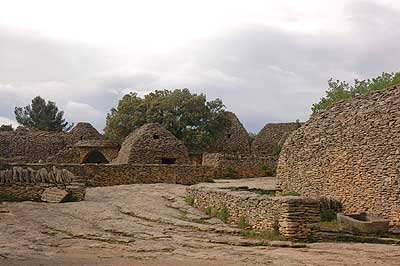
Heading back to Roussillon, we took a twisting one lane road bounded by stone walls with no room to pass to visit to the Beehives a mysterious village of stone, beehive-shaped huts called bories. It is believed that the village des bories dates back to the Ligurians who lived in the area at the time of Christ and was inhabited until the early 1800s. They are built with drystone (stone without mortar) according to the corbel vault principle.

Sun! What a delight to wake up to bright sunshine reflected off of Roussillon's ochre cliffs. Our host returned from the bakery with fresh croissants and baguette we enjoyed as we drank strong coffee out of large soup-like bowls - she explained the size allowed one to dunk their rolls in the coffee.

A leisurely drive through the Vaucluse to Lourmarin revealed rolling fields of poppies and lavender. ![]()
We stopped in Lourmarin – home of Peter Mayle - for lunch. Listed as "one of the most beautiful villages in France", it nestles in the middle of vineyards, olive groves and almond trees. It is a charming village with wonderful outdoor cafes but Mayle's writings of a Year in Provence seem to have increased the real estate prices as we noticed when we looked in estate agents' windows.
After lunch and several glasses of Pastis and wine, it was on to Aix-en-Provence where we thought that we might see the excitement of the French presidential election. Aix is a crowded and congested city but we found a delightful hotel, Hotel Le Manoir, in the centre of the city (with parking.) During the afternoon, Cours Mirabeau was crowded with a craft market but at 7 pm everything closed up, the restaurants went quiet and by the time we returned to our hotel to watch the election (8PM) everything was over. Sarkozy had been named the winner and in Aix it seemed as if no cared.
Monday morning we hurried to leave the city in search of our kind of small hillside towns. But none were to be found. L’abbaye du Thoronet is another fine old Cistercian abbey, located in forested hills halfway between Draguignan and Brignoles, just below the Argens River. The abbey buildings, church and cloisters were built in 1160-1190. In the 14th century, religious wars and politics resulted in it being abandoned and it wasn't until the eighteenth century that the abbey started to be used again, only to be sold off and abandoned during the French Revolution. The acoustics in the church are incredible as demonstrated by one tourist with an excellent voice that filled the whole space.
On departing, Tana identified a destination that sounded interesting, Collobrières – the chestnut capital - so we headed through the hills and down small roads till we came to it.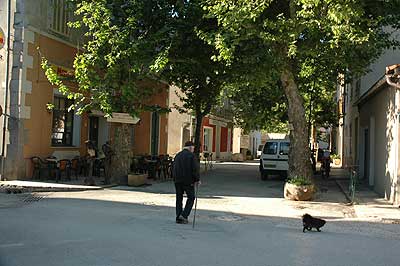
Collobrières looks like a little village on arriving, and it's easily lost in the forests of the surrounding Massif des Maures but it is a sizeable town old buildings painted in a variety of pastels, contrasting colored shutters and some wrought-iron balconies. On the wide Bvd Lazare Carnol shaded by huge old plane trees that passes through the center, we found a very reasonable hotel, Hotel des Maures (22 Euro), overlooking t he river Réal Collobrier that runs through town, with the central part of it like a canal along the edge of the buildings. At the north end of town, the road crosses the river on the Pont Raoul Calvi, a 12th-century stone bridge. ![]()

![]() Across the bridge is Chapelle Notre Dame de Pitié, and the Confiserie Azuréenne, who turns the sweet chestnuts that grow in the surrounding hills into candied chestnuts (marrons glacés) and purée. The town is a wonderful sleep one where the men play cards and walk there dogs with little to know traffic. Truly away from the maddening crowds.
Across the bridge is Chapelle Notre Dame de Pitié, and the Confiserie Azuréenne, who turns the sweet chestnuts that grow in the surrounding hills into candied chestnuts (marrons glacés) and purée. The town is a wonderful sleep one where the men play cards and walk there dogs with little to know traffic. Truly away from the maddening crowds. 
Our first choice for restaurant turned out to be closed on Mondays so we gambled on a corner restaurant, La Fairgoulette. Tres bon! We explained Tana's vegetarian bent and the chef whipped up a vegetable torte with a confit of onions slow cooked with little raisins, potato dumplings and tomatoes roasted with bread crumbs and herbs - one of her best meals. Meanwhile, George enjoyed steak tartare and creme brule with local chestnuts.
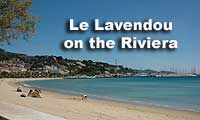
Le Lavendou - one night that turned into four
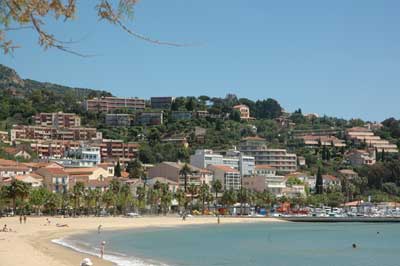 A windy trip the next morning led to Le Lavendou on the French Riviera, a beautiful area with sun, sand, lavender and cicadas. Le Lavandou, with over 12km of long, sandy beaches is located at the foot of the Massif des Maures in the heart of the Mediterranean coastal region of the Var in the south of France. We're not "beach people" but the scene encouraged us to stay one night so we found a reasonable hotel (Hotel L'Oustaou 50 Euro) one block or 60m from the beach in the centre of town.
A windy trip the next morning led to Le Lavendou on the French Riviera, a beautiful area with sun, sand, lavender and cicadas. Le Lavandou, with over 12km of long, sandy beaches is located at the foot of the Massif des Maures in the heart of the Mediterranean coastal region of the Var in the south of France. We're not "beach people" but the scene encouraged us to stay one night so we found a reasonable hotel (Hotel L'Oustaou 50 Euro) one block or 60m from the beach in the centre of town. ![]() >
>
Once settled, we started off towards St Tropez convinced that was a place we wanted to see since we grew up on Brigit Bardot movies such as "God Created Women" filmed in St Tropez.
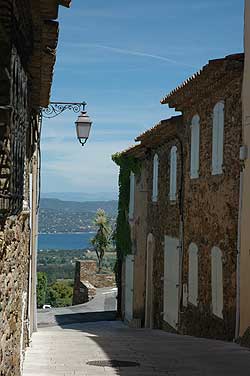
Following the coast, we detoured to Gassin in the hills overlooking the gulf of St Tropez.
And then it was on to St Tropez which, although somewhat pretty at a distance was actually dirty and crowded, with huge parking lots and filled with loud motorcycles
.
We settled for a small outdoor cafe for sandwiches, which we learned later was a mistake, and then hightailed it back to "our Lavandou."
As it turned out, lunch had been worse than we thought for George became quite ill that evening, evidently from food poisoning. The next morning, Tana went for a walk and an espresso while George slept in. Feeling somewhat better, we had a light breakfast at Chez Mimi  and then walked the beach, got our toes in the water and decided to stay one more night. Down the beach we came upon Bernard's Plague, a restaurant where one could rotate between swimming, eating and working on a tan. The fresh half pineapples were delicious.
and then walked the beach, got our toes in the water and decided to stay one more night. Down the beach we came upon Bernard's Plague, a restaurant where one could rotate between swimming, eating and working on a tan. The fresh half pineapples were delicious.
Thursday the weather was the same - warm, clear and sunny. We walked the beach and found espressos and a bathing suit for G so we booked another night and headed off to Bernards for the day. Le Lavendou is peaceful compared to other coastal town, where the locals play petanque on the courts in the medium of the main street.
Petanque is somewhat similar to the Italian bocce. The difference is that traditional bocce is more of a bowling game, whereas petanque is more of a tossing game, like horseshoes. Bocce players take steps before throwing while petanque players stand still. Bocce balls are usually rolled palm up, petanque balls tossed palm down, so they get backspin upon release. And petanque can be played on almost any terrain with an uneven terrain to make it more challenging.
That evening we discovered a small ristorante, Mimi and Thierry, close to the hotel where they created a special pasta for T. Friday morning we woke to a hazy sky and we wondered about the weather but the skies quickly cleared and we stayed another night. Back to Bernard's for sun and lunch - grilled dorade for G, salad for T. Then we walked the streets of the town that we now felt home in, and back to E&T for supper - pot of mussels with Roquefort sauce (G) and tagliattelle with cream, mushrooms, cheese and a raw egg on top to mix in (T)
Sadly the next morning we were up and on the road with a destination of Albe in Italy. We sped past Cannes and Nice but George wanted to see Monte Carlo again (last time was over 40 years ago.) It was beautiful but crowded as they set up the track and stands for the F1 race scheduled for the next week.

Not far east of MC is Menton where we stopped for lunch and ended up staying for one more night on the coast. Menton is the warmest and most Italianate of the Cote 'Azur resort spots, being within a couple of kilometres of the border. It has retained an atmosphere of aristocratic tourism not found in Nice or Cannes. It's ringed by protective mountains, so hardly a whisper of wind disturbs this suntrap of a city. Among other things, it is known for its year-round lemon crops.
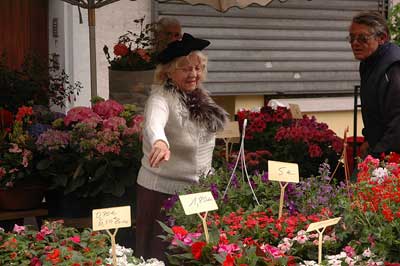 |
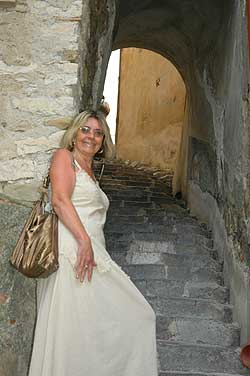 |
We chose to enjoy the aristocratic life-style for one night and booked into Le Royal Westminster Hotel on Promenade du Soleil with Campari on the lawn and dinner in the Dining Room.
 The coast was hard to say good bye to so, as we headed for the Italian border aiming at Parma or Montave, we stopped one last time in the Italian town of La Spezia for lunch of paninis and beer in a bistro on the harbour.
The coast was hard to say good bye to so, as we headed for the Italian border aiming at Parma or Montave, we stopped one last time in the Italian town of La Spezia for lunch of paninis and beer in a bistro on the harbour. ![]() The traffic was light and the roads good so we made it to Parma by mid afternoon but Parma was unappealing so Tana suggested that we move on to Sabbioneta, a small walled village in the plains north of Parma.
The traffic was light and the roads good so we made it to Parma by mid afternoon but Parma was unappealing so Tana suggested that we move on to Sabbioneta, a small walled village in the plains north of Parma.
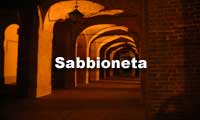
As we drove we couldn't imagine anything worth a visit in the pasture lands. Even as we approached Sabionneta we thought that it would be no place to linger. But once inside the walls we found a wonderful rural town with its own life. To attract tourism, the village had tried to promote its history as a utopian princedom. Apparently in the 16th century, Vespasiano Gonzaga Colonna tried to build a city "misura d'uomo" ("made to man's measure") but failed. Utopia it was not, but cute and folks it was with its country market, old theatre - Teatro all'Antica - (the first building ever constructed to specifically serve as a theatre) and Palazzo Ducale. We found Albergo Al Duca within the walls and stayed the night,
Monday was our last day and we had to get within easy distance of Marco Polo Airport so we chose to stay in Treviso. From there we could travel to Venice by train for 2 Euro and drive the next day to the airport in 15 minutes. We found an ideal B&B (B&B La Terrazza) with parking just outside of the walls and only a few minutes walk to the train station-XX. The train to Venice runs about every 20 minutes so we made it to the Dorsoduro for a late and fare well lunch. The heat and the crowds made leaving Venice easier as we returned to Treviso for the evening.
There we discovered that there weren't a lot of restaurants but finally after staggering through a very quiet old town found a terrific restaurant in Piazza del Signori where the food (mostly pizza) was terrific. A fond farewell dinner for the trip.
Tuesday was up and at the airport with flights to Munich, a stopover in Toronto for 6 hours and home to Victoria - all in the same day.
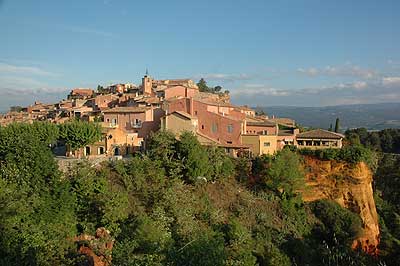
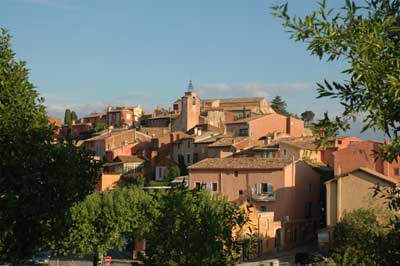


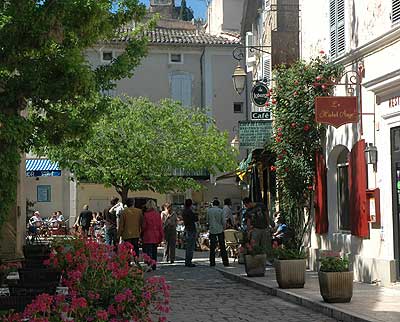
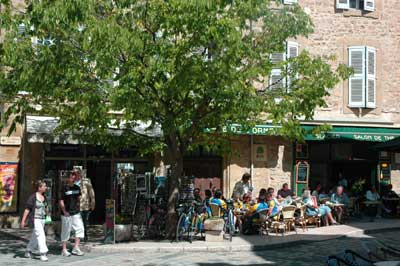
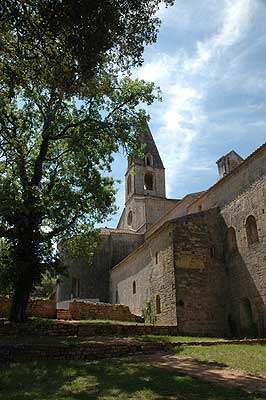
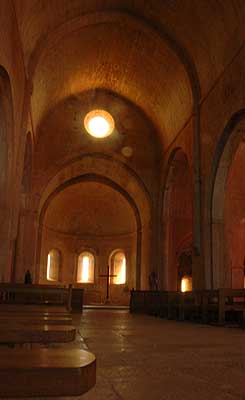
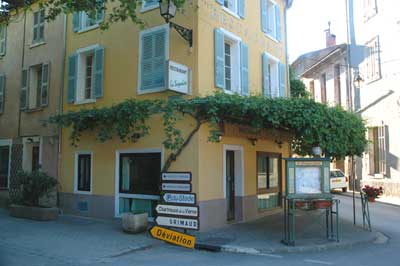 <
< 